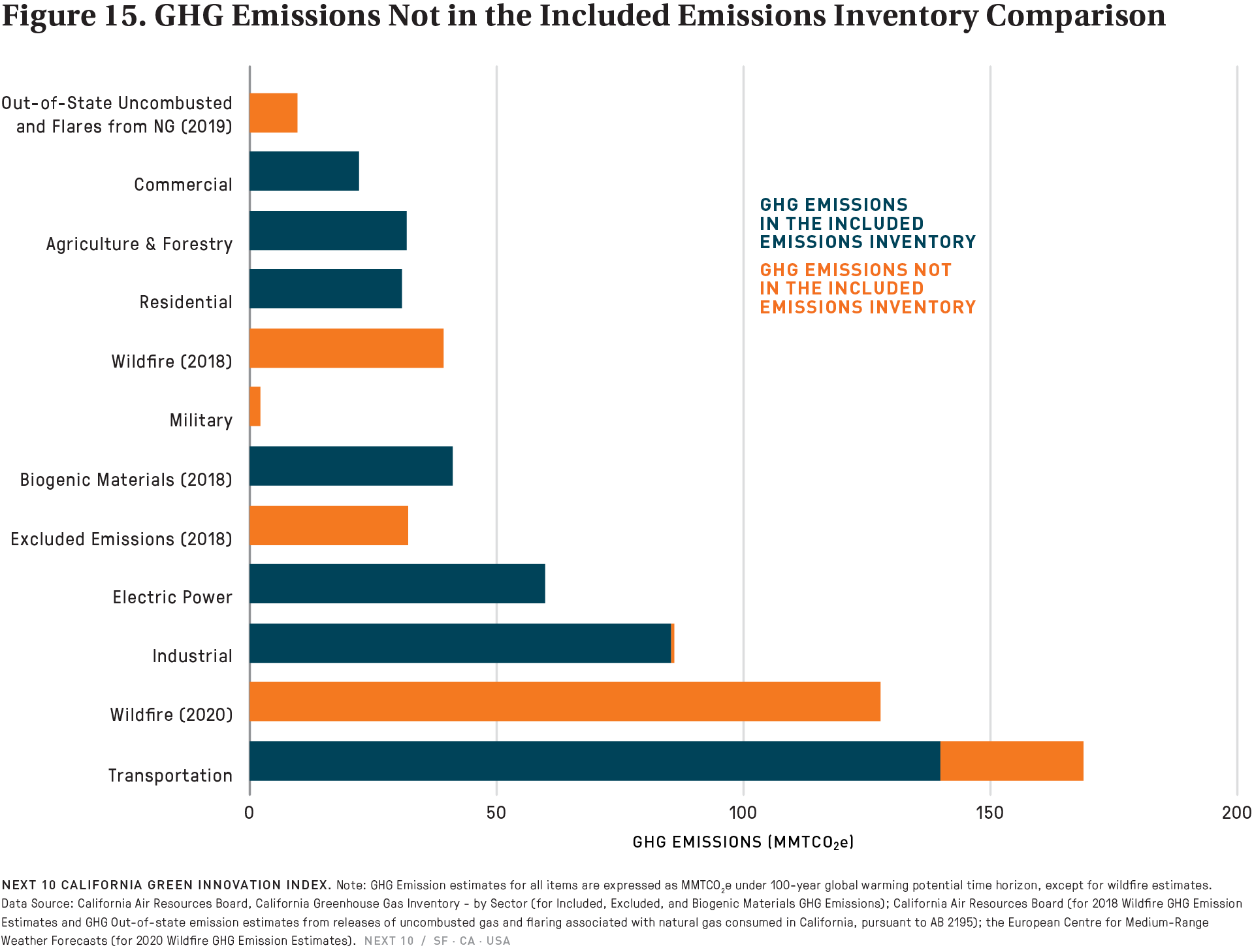Highlight
- The amount of GHG emissions from transportation that were excluded decreased significantly from 2019 by 42.3 percent, mostly from aviation and water-borne travel. The amount of GHG emissions from the loss or release of uncombusted natural gas to the atmosphere due to extraction and emissions from natural gas are estimated to continue climbing, as California used 2,075 billion cubic feet of natural gas in 2021.44 The increase is driven by an increase in import volume (+5.7%). In the electric power sector, power facilities have experienced an increase in emissions in 2021, particularly, in the metal and power plants sectors. Although the power plants’ emissions have been on a steady decline since 2013, the sector emitted 35.43 MMTCO2e in 2021, up from 33.67 MMTCO2e in 2019 (+5.24%), which was closer to the 2016 level of 36.77 MMTCO2e. In September 2021, the California Legislature voted to extend the operation of Diablo Canyon Plant, the state’s last nuclear power plant, beyond the planned decommission in 2025.45 The clean generation provided by the nuclear plant reduces the need for gas-fired generation and lowers emissions by 10 percent through 2030.46
44 California State Energy Profile. U.S. Energy Information Administration. Last updated March 17, 2022. Available at: https://www.eia.gov/state/print.php?sid=CA
45 Rott, Nathan. California Lawmakers Extend the Life of the State’s Last Nuclear Power Plant. NPR. Sept. 1, 2022. Available at: https://www.npr.org/2022/09/01/1119778975/california-lawmakers-extend-the-life-of-the-states-last-nuclear-power-plant
46 Extending Diablo Canyon Plant Could Reduce Calif. Emissions by 10% Through 2030. S&P Global Market Intelligence. June 8, 2022. Available at: https://www.spglobal.com/marketintelligence/en/news-insights/blog/extending-diablo-canyon-plant-could-reduce-calif-emissions-by-10-through-2030
Challenge
- Emissions stemming from wildfires are producing more GHGs than ever. Emissions from wildfires47 in California totaled 127.7 MMTCO2e in 2020, more than any other economic sector except for transportation, and compared with about 65 MMTCO2e of reductions achieved across all sectors in California in the previous 18 years. The wildfires that year also contributed to more than $19 billion in economic losses.48 Wildfires are a natural part of forest cycles and therefore not included in the GHG inventory. However, the increase in number and severity of wildfires in recent years is concerning. While emissions from wildfires in 2021 is not yet known, there were significant fires across the state. The California Air Resources Board is now starting a process to include wildfire emissions in its future Scoping Plan,49 which focuses on achieving carbon neutrality by 2045.
47 According to California Air Resources Board, wildfire emissions contribute to climate change. It is important to note that emissions from wildfires are not part of the included emissions inventory, which is concerned with GHG emissions from fossil fuel combustion and other anthropogenic emissions. Since wildfire emissions are not necessarily the result of fossil fuel combustion or other anthropogenic activities, these are not considered to be part of the included emissions. In addition, fire is a natural and critical ecological function for maintaining healthy and resilient forests, and it supports several ecosystem functions such as facilitating germination of seeds, replenishing soil nutrients, stimulating tree growth, and reducing fuels. This is another reason why wildfire emissions are estimated separately and are not part of the included emissions. For more information, please visit CARB’s webpage: https://ww2.arb.ca.gov/resources/documents/frequently-asked-questions-wildfire-emissions
48 As forests go up in smoke, so will California’s climate plan. Los Angeles Times. August 29, 2022. Retrieved from: https://www.latimes.com/environment/story/2022-08-29/forests-wildfires-california-climate-plan
49 According to the California Air Resources Board, its 2022 Scoping Plan Update assesses progress toward the statutory 2030 target while laying out a path to achieving carbon neutrality no later than 2045. https://ww2.arb.ca.gov/our-work/programs/ab-32-climate-change-scoping-plan/2022-scoping-plan-documents

